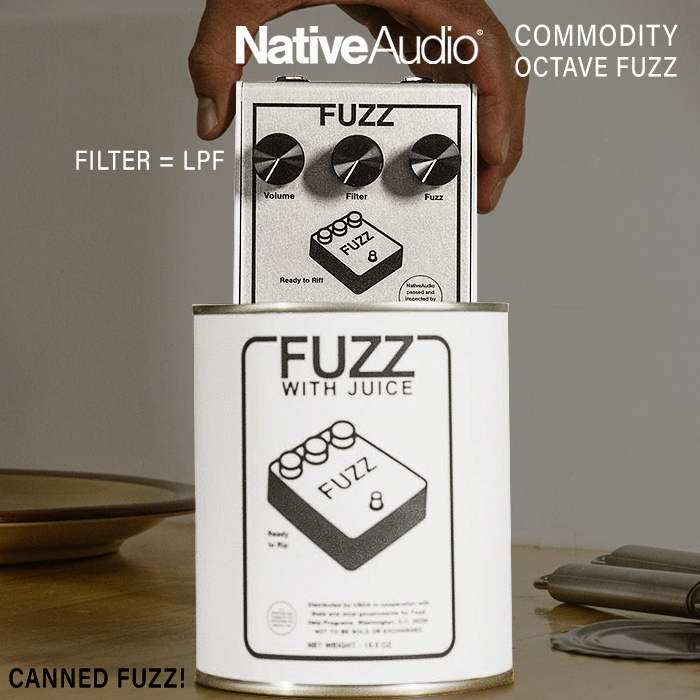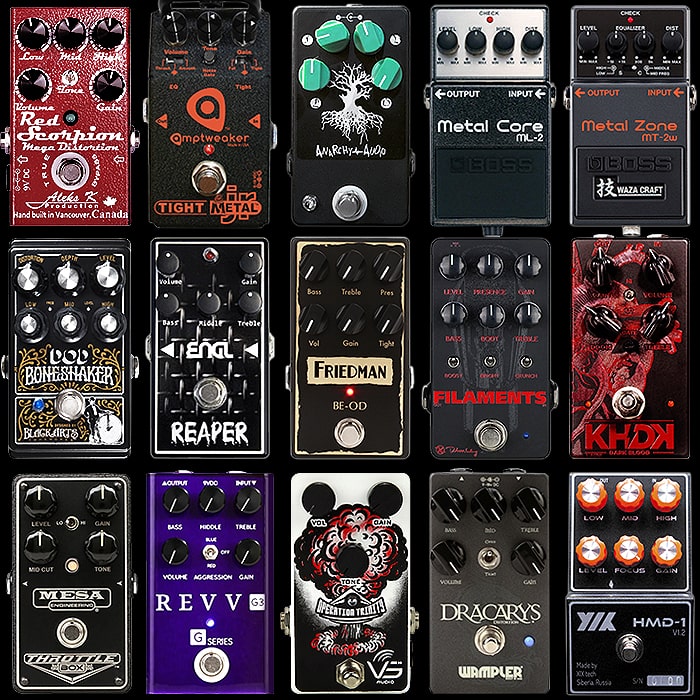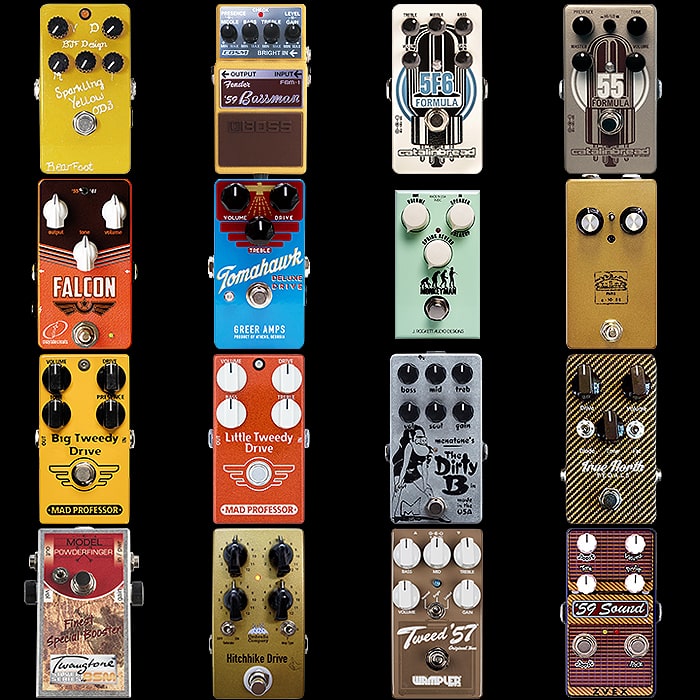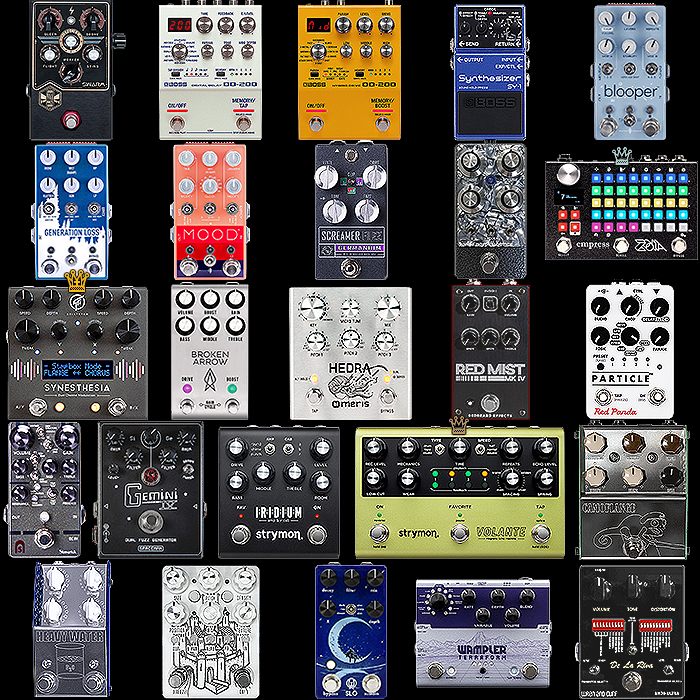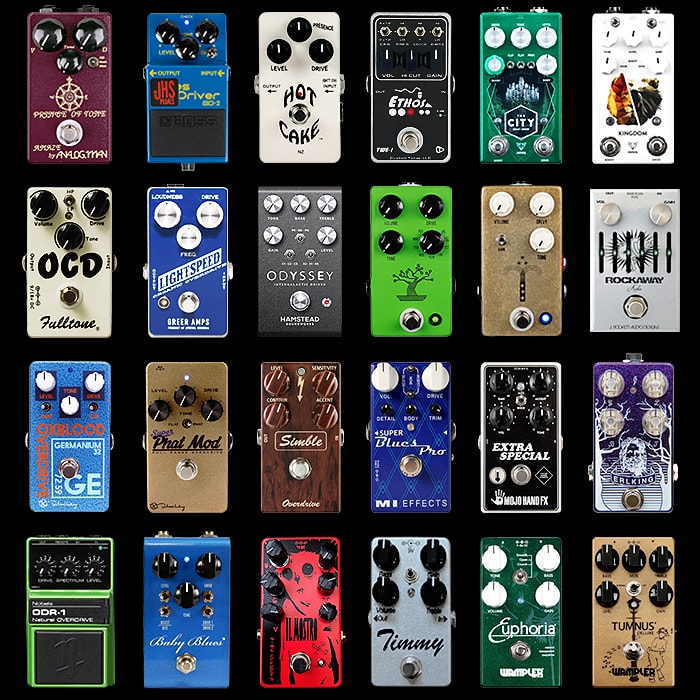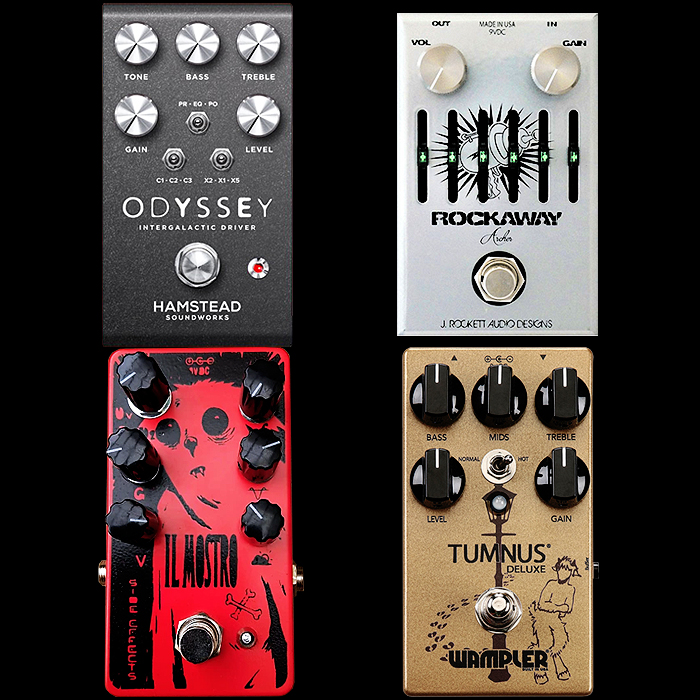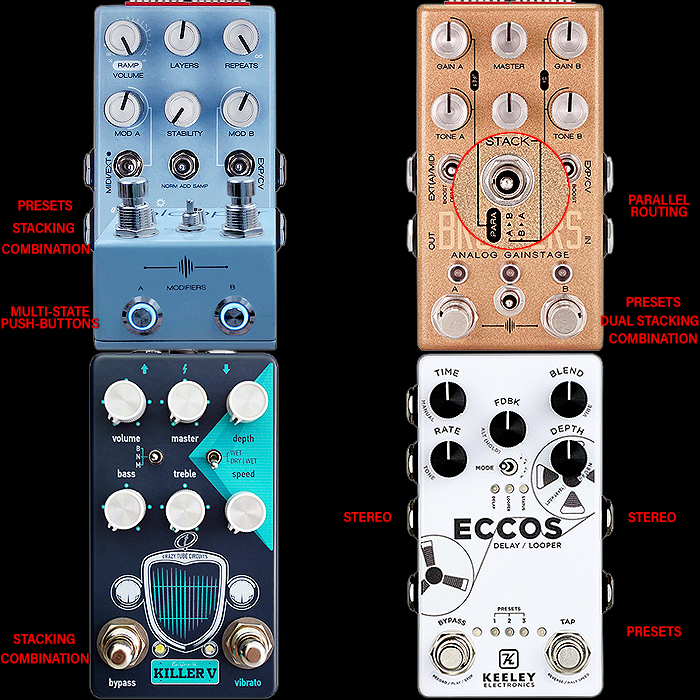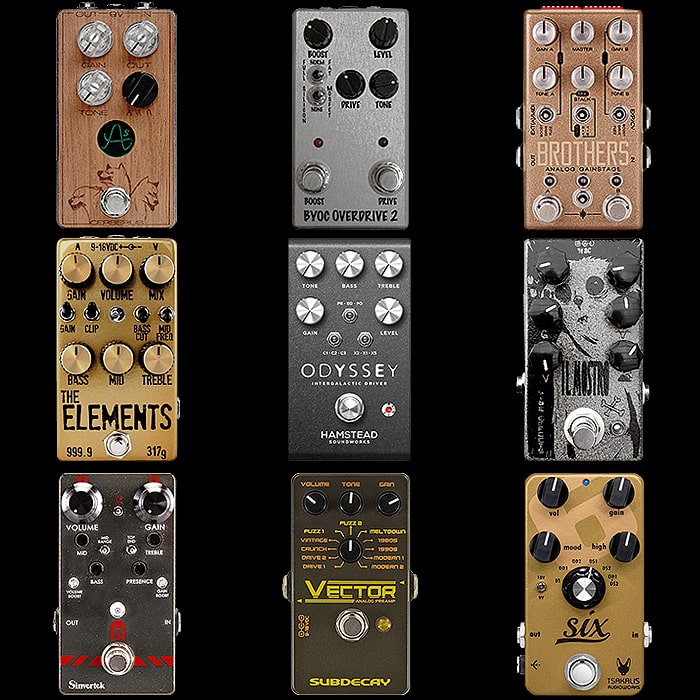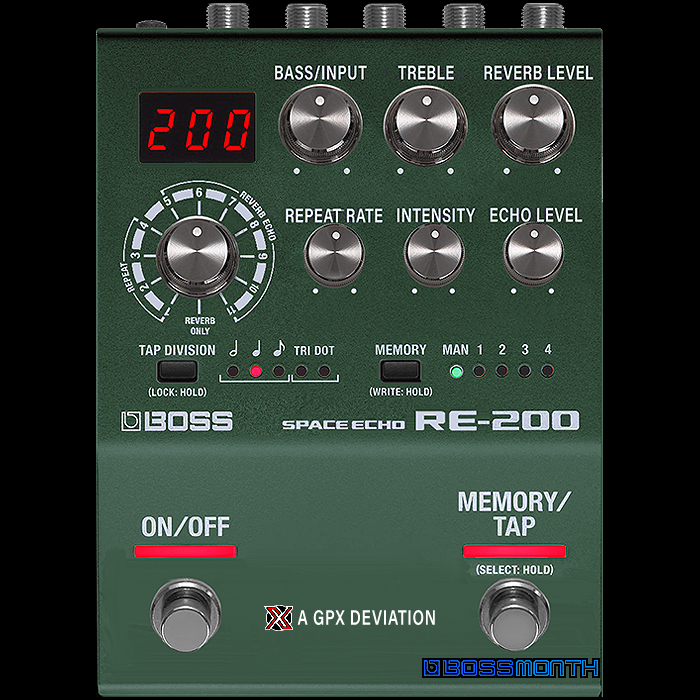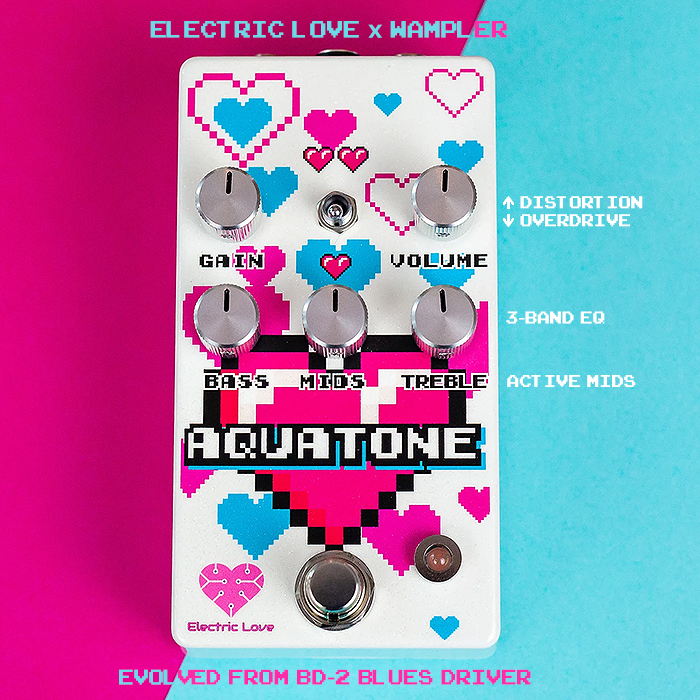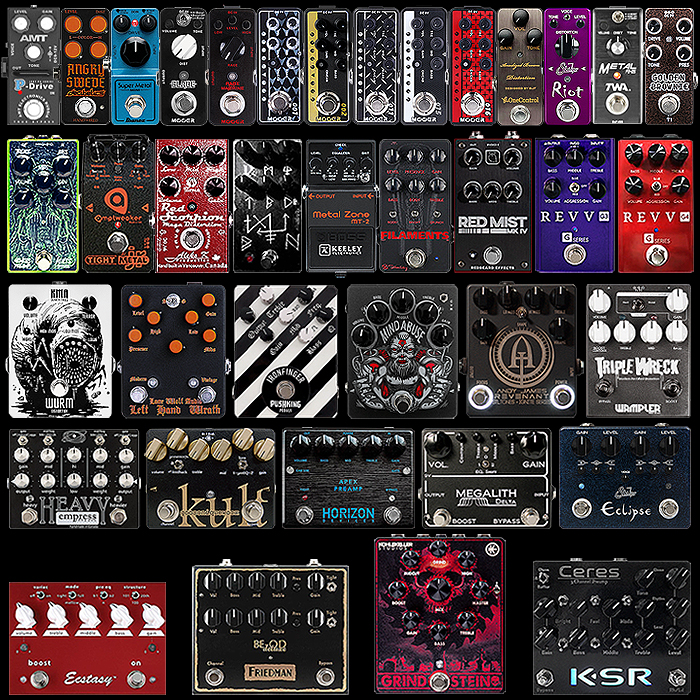Boss OD-200 Hybrid Drive In-Depth Review and Long-Term Impressions

This review has taken somewhat longer than I intended - partly because of the considerable scope of variations covered by this pedal, and partly because of my ongoing changing adapted approach to deploying the pedal. My first instincts always seems to lean towards a philosophy of replication and replacement - that is to say trying to figure out which of my preferred / favourite dirt pedals can this one competently stand in for and replace if need be. I have lots of favourite fuzz, drive and distortion pedals (circa 300 + 100 modulations and time-based effect pedals) - and I’ve always been actively seeking a sort of ’one ring to rule them all’ sort of Multi-Drive Device - not that I’ve yet really found any that come wholly close enough to my requirements.
My first encounter with such an all-rounder pedal was the Elektron Analog Drive - an all-analog 8-circuit behemoth - drive, fuzz and distortion pedal. This obviously has a considerable down-side in its huge footprint, but more significantly, and even though in and of itself it sounds pretty great - it did not come close to any of my own personal favourite drive flavours. Overall it was/is a really clever pedal - with multiple presets and a pretty extended feature set including parametric mids - but it could really have done with a boost element, and the enormous size quickly became a significant disincentive for me. I still have said pedal - but it comes out to play very rarely nowadays, and in fact I’ve not touched it for probably a couple of years now.
Following on from the Analog Drive I have had a number of Multi-Drives in and around my pedal-chain - including the fantastic BYOC Crown Jewel Multidrive and Empress Multidrive - both excellent pedals, but lacking in some features (presets in particular) to make them properly useful in an extended live playback scenario.
And so with the OD-200 I made my usual mis-step in starting the process by trying to exactly replicate some of my favourite drive pedals - which include the following selection in sort of 12 Degrees of Saturation order:
- Klone : Decibelics Golden Horse, ThorpyFX Peacekeeper
- Tube Screamer : Jackson Audio Broken Arrow, JHS Bonsai
- Dumble-style : Demon Pedals Kondo-Shifuku D-Style Drive
- Blues Driver : Keeley Modded Boss BD-2 Blues Driver Phat Mod / Freak Fuzz Edition
- Triangle Big Muff : Basic Audio 5-Knob Tri/Ram Fuzz
- Vox Top Boost Distortion : Bearfoot FX Emerald Green Distortion Machine
- Brown Sound Distortion : MI Effects Super Crunch Box V2 / Boss JB-2 Angry Driver
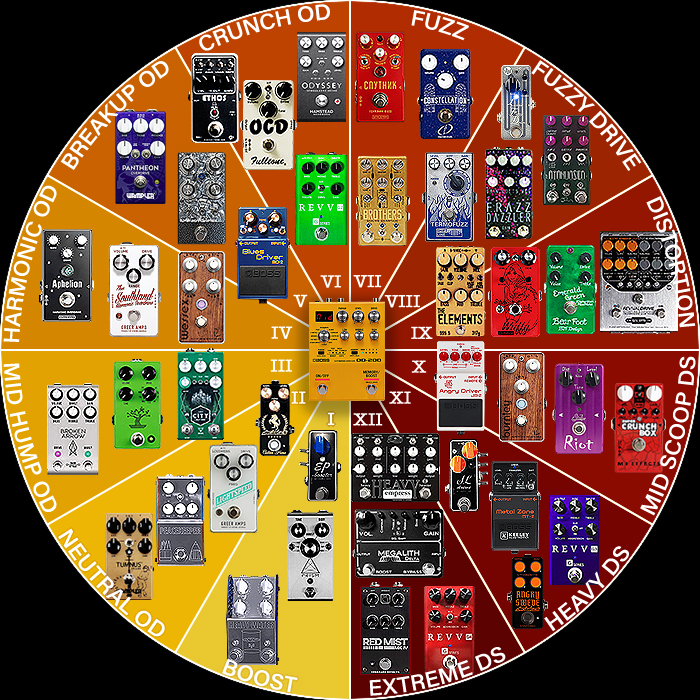
I was intending to go through each of the voicings and compare them to / try to tune them to the most obvious equivalents of my own favourite preferred pedals - for instance using the JHS Bonsai OD-1 voicing. In fact now is a good time to explain the very top and main visual - where I've tried to equate each Drive Type voicing / Mode on the main Mode dial with my perceived Boss equivalent pedal - as follows:
- OVERDRIVE - Boss OD-1 OverDrive
- BLUES - Boss BD-2 / BD-2W Blues Driver
- SCREAM - No direct Boss Tube Screamer / OD808 equivalent - simulated pedal graphic
- CNTR OD - No direct Boss Klon Centaur equivalent - simulated pedal graphic
- X-DRIVE - Boss OD-1X OverDrive with MDP Multi Dimension Processing DSP *
- DIST - Boss DS-1 Distortion
- X-DIST - Boss DS-1X Distortion with MDP Multi Dimension Processing DSP *
- STACK DRIVE - Boss ST-2 Power Stack
- FAT DIST - Boss MD-2 Mega Distortion
- BROWN - Boss JB-2 Angry Driver
- X-METAL - No direct boss X-Metal equivalent with MDP Multi Dimension Processing DSP * - simulated pedal graphic
- FUZZ - No direct Boss Big Muff Fuzz equivalent - simulated pedal graphic
* - MDP / Multi-Dimension Processing is Boss's own proprietary 4th generation Digital Signal Processing methodology which has been designed to maintain individual note clarity and dynamics throughout every variation of EQ and Gain saturation.
There seems to be quite some degree of misunderstanding in the marketplace as to what exactly some of these modes are supposed to represent - with different reviewers mentioning somewhat diverse equivalents - but by and large the modes tend to offer a wider range of tone-sculpting possibilities and gain than the stand-alone pedal equivalent originals. I also feel that my own extrapolations are about as close as they could be - noting that you don't always get exact equivalency in terms of the extended knob ranges and different tapers on the OD-200.
In any case, I soon ran into similar scenarios I had with the Analog Drive all that time ago, but not nearly as acute or pronounced - When you're doing side-by-side and exact audio comparisons then the differences can really stand out, even though the overall character may be very close. Let me try to explain what I mean by that - in terms of how the OD-200 manifests for me, and what I can discern from its overall tonal characteristics and timbres.

First off the bat I have to say that the pedal is very impressive on first run-through - with none of those obvious DSP side-effects or inherent signal-processing give-aways. Yet if and when you do head-to-head comparisons with equivalent analog pedals - there are certain differences that become very quickly evident.
With any drive pedal there is a considerable vocabulary that can be applied to describe those key tonal characteristics and timbres you are hearing, with several other more subtle differentiators involved too:
- Hard vs Soft
- Dark vs Bright
- Cold vs Warm
- Compressed vs Open
- Brittle vs Smooth
- Thin vs Fat / Well-Rounded / Full-Bodied
- Dense / Plastic vs Elastic
- Flat vs Harmonic / Textured
- Rigid vs Chewy
- Artificial vs Organic
- Tight vs Loose
- Coloured vs Transparent
etc.
It has to be said that the OD-200 has a lot of different voices differently applied, while there are some fairly distinct characteristics in the core default tonal profile that seem to be pretty constantly there. This includes a slight hardness to the overall timbre of the drives and distortions on the basis of soft versus hard clipping effect equivalency. I am also aware of a very slight hint of darkness in most of the profiles. This is particularly evident when dialling in Low and Middle frequencies - which for instance when compared to my Basic Audio Tri/Ram when you ramp up the equivalent Fat / Lows knob you get more bass / low-end for sure, but it applies a harder texture with it and more density on the OD-200, while the Bass on the Tri/Ram is somewhat softer and more open, which makes the Tri/Ram sound somewhat warmer too.
The same is largely true of the Middle EQ frequencies - where they don't seem to be as elastic or chewy as many of my preferred Marshall-esque / Plexi pedals. That does not mean you cannot get amazing tones out of the OD-200 - is just means the character of the voicings is often somewhat slightly different in the overall nuances of texture and feel.
With my initial foray into head-to-head comparisons I found I could get pretty close to most of those I tried bar the Dumble-Style drive - which is a really elegant fuzz-edged drive/distortion or fuzzy-drive even as I like to call it. Yet I tried here to apply the FUZZ voicing to a tiny degree combined with the OVERDRIVE Boost, and then vice-versa - but the character and taper of the Big-Muff style FUZZ just isn't sufficiently nuanced for creating those subtle Dumble-Style tones - so that was the only significant failing / omission really. In fact the Big Muff style FUZZ voicing itself was the first one I really bonded with, and I was able to get really excellent Triangle and Ram's Head style flavours really very quickly and easily. In direct head-to-head comparisons with the Basic Audi Tri/Ram there was a marked difference in the Low and Middle frequencies - yet the OD-200 still sounded pretty stellar with its own voicing. I feel this is a really great Muff-style voicing where you can easily dial in Triangle, Ram's Head and even Green Russian style varieties - and when combining with the different boosts - almost anything is possible here - bearing in mind though that the OD-200 does have its own distinct distortion character.
So the FUZZ voicing was the first big success for me, and then I found I could also pretty easily dial in some Stellar OVERDRIVE, BLUES, SCREAM, CNTR OD and DIST voicings. The 'X' drive variants actually took me some time to get used to - even though I have a DS-1X pedal myself - there is a touch of an unusual feel to that which takes some getting used to - as you don't get the typical saturation bloom you get with conventional analog pedals so it does not initially react exactly how you're used to. I feel that it will take me a while to get to grips properly with the X-DRIVE, X-DIST and X-METAL modes - even though the last mentioned was actually the easiest to dial in of those - but generally from X-DIST through to X-METAL I preferred to apply those in conjunction with a BOOST - as we will cover in the next part below.
I might also question the omission of certain drive types versus some of these chosen - for instance I think a RAT voicing would have been another great flavour here possibly in place of the FAT DIST. But overall this is a really cleverly set up and calibrated pedal with some minor flaws for sure - which I will detail in the third chapter below. Overall though I'm actually really impressed with the OD-200 - with the Interest Curve veering from excitement and wonder to bemusement and surprise and then a quiet glow of satisfaction at the end. I did not find all the voicings necessarily wholly useful for me or even entirely to my liking - but there is so much here, and on pretty much every voicing you can dial in something interesting at the very least - albeit you need to be careful with differences in DRIVE/Gain taper and LEVEL/Volume unity when switching between modes.
In short, the modes I enjoy the most are OVERDRIVE, BLUES, SCREAM, CNTR OD, DIST, BROWN, X-METAL and FUZZ surprisingly in particular! With my being able to dial in extremely satisfying variations of each.
Note also that I was considering sharing my own settings for some of these - but they are so rig-specific I've noted that other players boost the Lows while I usually roll them back a little etc. You're fine off starting in the usual Boss default position with every dial at noon / 12 o'c and adjusting to taste from there - note also that there can be a fairly significant / audible difference in volume and gain for each of those 12 o'c positions. Level runs 0-100, Drive 0-120, and each of Low, Middle and High are -50 to +50 Active EQs.
I would think with 12 DRIVE Types, 15 BOOST Types and 180 combinations / permutations of those deployed together - there should really be something here for everyone.
The Many Boost Modes of the OD-200 and their Various Applications

One of the surprise elements of the OD-200 for many of us was its vast array of BOOST modes, and how Boss allows you to apply them both in Parallel and Series - the first as more of a touch of a texturising and thickening agent, while the Series Boost gives you lovely blooming saturation and extra richness.
In my above visual I have attempted to distil all the key elements of deploying a BOOST, including the different varieties and applications, and how to switch between the key modes and parameters. There are 15 BOOST TYPES in the OD-200 - 10 of those are the same as the Drive Types on the main Drive Mode / Type dial, while 5 are unique to BOOST, the full overview is as follows:
- Mid : Mid / Solo Boost
- CLn : Clean / Transparent Boost
- trb : Treble / Bright Boost
- oVd : OVERDRIVE Mode (OD-1 OverDrive) as Boost
- bLS : BLUES Mode (BD-2 Blues Driver) as Boost
- SCr : SCREAM Mode (TS 808 style) as Boost
- Cnt : CNTR OD Mode (Klon Centaur) as Boost
- Hdr : X-DRIVE Mode (OD-1X OverDrive) as Boost
- dSt : DIST Mode (DS-1 Distortion) as Boost
- HdS : X-DIST Mode (DS-1X Distortion) as Boost
- StK : STACK DRIVE Mode (ST-2 Power Stack) as Boost
- FAt : FAT DIST (MD-2 Mega Distortion) as Boost
- MZn : MT-2 Metal Zone as Boost
- MCr : ML-2 Metal Core as Boost
- FuZ : FUZZ Mode (Big Muff style) as Boost
When I started applying the various BOOST TYPES, I initially got a little confused between the PARAM Button and PARAM Knob and main LEVEL knob too - often inadvertently reaching for that to set higher level of Boost - before it all snapped into place for me and settled into am established pattern.
PARAM BUTTON FUNCTIONS
- TYPE - When Red LED is on TYPE - use PARAM Knob to cycle between above referenced 15 BOOST TYPES
- POST - When Red LED is on POST - use PARAM Knob to set level of Volume Boost : 0-100, default value : 60
- PRE - When Red LED is on PRE - use PARAM Knob to set level of Gain Boost : 0-100, default value : 110
- DECAY - When Red LED is on DECAY - use PARAM Knob to set how quickly signal fades away or sustains - higher values means more sustain, lower values means more Tightness : 0-100, default value : 30
- THRESH - When Red LED is THRESH - use PARAM Knob to set trigger level or sensitivity for when Gate comes into effect : 0-100, default value : 0
BOOST STRUCTURE FUNCTIONS
As mentioned, you can have the BOOST either in Serial mode (default) or in Parallel mode. To switch mode you will need to enter Global Settings by pressing on both PARAM and MEMORY buttons simultaneously. You should then notice that the Main LED Display changes to 'Str' which is the first of the Global Settings. Press the PARAM Knob down to switch between SEr (Series) and PrL (Parallel) BOOST Modes.
When I started playing around with BOOSTS I thought I would surely just have them all set to Parallel as that is how I most enjoy using my JB-2 Angry Driver pedal, but you get quite different outcomes obviously in each mode - with the SEr Boost giving you more saturation bloom and body overall, while the PrL type kind of doubles up the texture - particularly evident when using same Drive TYPE and BOOST TYPE together - e.g. BLUES and BLUES - you get a richer more harmonic texture - somewhat akin to double tracking, but it does not fatten up the sound a whole deal - thicker yes, but not necessarily fatter - if you want fatter and more body - then you are better of with 'Ser' mode - where I now find I use both for quite different purposes.
Much like with the DRIVE TYPES I started by matching up all the usual suspects and testing very much known paradigms and combinations, while latterly I took to just more freestyle experimentation and trying more interesting DRIVE and BOOST combinations. Note that the EQ knobs in particular have a lot of range to them and relatively small movements can lead to pretty significant changes when searching for sweet-spots.
I found that generally you are better off not trying to dial in or match the pedal to some arbitrary reference tone, but rather play away and see where each voicing takes you. I can kind of appreciate Boss's approach now - where before I was more looking our for a series of 'Serving Suggestion' style settings charts for achieving particular tones, while the strength of this pedal is in its general scope and breadth of coverage, and just how many great sounding tones there are to be found within it - but you must seeks those out yourself. That does not mean you will not still have favourite variants of each voicing in original / analog pedal format.
There is so much to like about this pedal you get taken through a whole series of emotions, there are however some notable quirks or flaws however you wish to interpret them which need to be brought to light - per the next chapter.
Living with the OD-200 Long Term - Notable quirks, glitches and oversights

For such a superficially simple looking pedal, there is actually some degree of complexity here, and there is a slight but significant learning and familiarity curve towards getting the best out of this device. I have spoken to many OD-200 owners / users and most of them have had a similar experience of the pedal to myself - with one of the key initial aspects just being the basic utility and usability in applying BOOSTS and PRESETS.
I and several others inadvertently found ourselves reaching out for the LEVEL dial when meaning to adjust the BOOST Level and forgetting initially that it is the PARAM knob that adjusts all BOOST functions and values. So until I got used to it, I was forever messing up my core settings by inadvertently trying to tune the Boost with the LEVEL dial. Possibly that knob needs to be renamed to something more specific?
The next issue that I encountered which is quite a significant one - is that if you're playing on the main panel / MANUAL settings, and then move the MEMORY Green LED along to Preset 1, 2, 3, 4 and back to MAN - by pressing on the MEMORY button or right-hand footswitch - once you cycle back to MAN again all the values you had dialled in on the BOOST have been reset to defaults - i.e. POST 60, PRE 110, DECAY 30, THRESH 0 - and if you had selected PrL mode for Str Structure - this is back to default SEr Series mode again - which I and various others find really quite infuriating - this really needs to be fixed.
Another issue is with the Main LED Display for Presets / MEMORY - where when paging through those, the display only shows you the Preset slot - M1, M2 etc., BOOST applied and whether it is on or off (by way of a sort of full-stop or dot at the end), but at no time do you see the actual DRIVE TYPE selected. In fact the Display is 99% for BOOST, GATE elements and Global Settings, while the only time you get the DRIVE TYPES appearing on the screen is when you initially rotate the main DRIVE TYPE knob and see a very brief glimpse of the one you have landed on before the display flips/reverts back to BOOST Type selected or equivalent parameter governed by where the PARAM Button LED is set to.
I also find some of the Global Settings rather opaque - and question somewhat the choice for having such a low-res display screen. With a little higher resolution you could have two rows of character display - which could permanently show DRIVE TYPE and BOOST selected on separate rows, as well as Global Settings Category and Setting selected within that. At the moment the utility of the LED panel is really only around 50% of what it could / should be!
Finally for such a wide-ranging pedal - why only have 4 Presets? You have 12 DRIVE TYPES and 15 BOOST TYPES - why only 4 Memory slots? It would be minimal effort to ramp this up to the 8 Preset display specification which the Wampler Terraform for instance uses so effectively - i.e. all lights on bar one as I've illustrated. for slots 5-8.
For such an overall great pedal the above quirks and glitches do somewhat dent the overall ownership experience, although I doubt those alone would be enough to disqualify the pedal overall for the vast majority of players. Obviously some of these things can be fixed with a version update, while the display-panel limits will need to be addressed in a V2 at some stage in the future.
Demos and Serving Suggestions
I was trying to figure out what to recommend as the best jump-off point for the OD-200 when everyone's favourite eponymous Scottish YouTuber - Colin Scott - weighed in with a quite brilliant take on the OD-200 were he approached it from the perspective of interesting gain stacking combinations:
- DIST dSt DRIVE TYPE + SCREAM Scream BOOST - SEr / Series Mode
- STACK DRIVE StK DRIVE TYPE + FUZZ FuZ BOOST - SEr / Series Mode
- X-DIST XdS DRIVE TYPE + METAL ZONE MZn BOOST - SEr / Series Mode
- DIST dSt DRIVE TYPE + BLUES bLS BOOST - SEr / Series Mode
- OVERDRIVE oVd DRIVE TYPE + CNTR OD Cnt BOOST - SEr / Series Mode
- BROWN brW DRIVE TYPE + X-DRIVE BOOST - PrL / Parallel Mode
I would like to contribute an additional favourite combination of mine - the JB-2 Angry Driver equivalent!:
- BROWN brW DRIVE TYPE + BLUES bLS BOOST - PrL / Parallel Mode
This is a great way to get to know the pedal - so thanks to Colin for that smart perspective on his demo.
All in all there haven't been that many OD-200 demos - and I will assign the most significant ones here - including ones from Rabea, Joss Allen, and The Super Fun Awesome Ozzy Guys - who actually did one of my favourite takes before Colin's moment of genius materialised today.
I've also included the demo from Leo Gibson - to sort of demonstrate against doing the head-to-head match-up with analog pedal originals. They have different components, frequency profiles, 'Q' bandwidth values etc. which differences become very evident on a direct comparison basis - sure you can get some great tones of that type and firmly in that ballpark and identifiably so, but there are subtle nuances in the warmth and softness of a particular articulations and breakup distortion which the OD-200 just cannot fully replicate. Possibly we will get a more pro version OD-500 or similar later with more parameters - such as Presence, Resonance, Clipping Options, Parametric EQ's and Q-values. Up until such a stage the OD-200 will be the leading all-rounder - but it cannot absolutely match everything that is out there! The BYOC Crown Jewel is far more adept at that with its own modular boost components, parametric mids, Q-values etc. - but that is an entirely manual process and has no presets!
I still believe that for many the OD-200 will be the perfect solution, possibly not for the higher echelon audiophiles and purists though!
Final Thoughts and Recommendations

I've watched keenly each of the demo videos released to date, and I don't feel any of those capable artists has fully gotten under the skin of this pedal. Obviously there are so many genres covered here that they are unlikely to absolutely all appeal to everyone. Yet I do feel that someone could get a pretty great tone out of each Voicing - which I have so far failed to see. There's a lot of misinterpretation and misrepresentation generally, and Boss does not always help itself with some fairly opaque instruction references at times, and lack of general ball-parking, benchmarking and tone-signature referencing. That said I understand to a large degree why they took that stance with this particular pedal.
Where I see this pedal is as a great all-rounder and supplemental pedal, and sometime gigging and studio tool for those players that don't quite know what they will need at the time and need something versatile to bring along. That said the small number of presets available here generally limits this pedal for that kind of work as having just 4 settings you can rely on is nowhere near enough really for most established musicians.
I could say that this is great for players wanting to get as wide a tonality as possible, or wanting to explore and discover these different core tone families and genres. But then I kind of took that path early on in my gear days and decided I much preferred learning first-hand from the original pedals, how they work, how they sound - and extrapolating from that - rather than working backwards from the OD-200.
One of the bests Gain Structure teaching tools for me is/was the BYOC Crown Jewel - with its plethora of clipping and EQ options and a pretty extraordinary palette of tones right across the different characteristics of Warm, Cold, Soft, Hard, Strident and Smooth. The OD-200 does not really teach you the fundamentals of gain-structuring, and it could probably do with a couple more parameters/attributes to get some of the tones that the the Crown Jewel so easily delivers.
I actually really like the OD-200 - it's in my current pedal-chain as you can see from the above visual, but I use it Supplementally rather than as a Primary in most respects - as I still have preferred analog pedals which the OD-200 cannot quite equal on total tonal and textural fidelity. It comes very close on many of them - it does a great OD-1, BD-2, Tube Screamer, Klone, DS-1, JB-2 (mixing BROWN with BLUES BOOST), HM-2, ML-2 and MT-2 - and I still probably like it's Big Muff-style FUZZ mode the most - which is a real surprise to me.
The OD-200 is such a capable pedal that I've just got caught up in jamming away far too often, and forgotten the laborious task of documenting and calibrating each setting. I'm actually not sure it's a great beginner's pedal really, as I feel newbies would not necessarily have the appropriate references, experience or skill to get the best out of this pedal. Vastly experienced players also prefer typically sticking to what they know - so this is not necessarily for them either - as they would need to get to know and figure out the pros and cons of this pedal - and how best to dial it in.
So this pedal is best aimed at players like me - who have a wealth of experience with drive tones and largely know how things work and what they like. Obviously experimental players will have a whale of a time with this - discovering new varieties of combinations. So modern, progressive, open-minded players should love most of what is on offer here, while this is not one to covert all the traditionalists and doubters. I was marginally surprised by the tonal quality of the pedal - in that in sound and feel you would really not discern in as being DSP - beyond those 3 specific MDP modes where the playback feel is somewhat changed.
I feel this will find best use for somewhat agnostic players - meaning non-partisan tone seekers who generally favour new technologies and aren't afraid to experiment. I think overall on an engineering scale this is hugely impressive, although there are a few too many concessions to simplicity and cost-effectiveness rather at the expense of usability and playability.
I would most definitely recommend this pedal - it is probably the best DSP derived drive pedal I've encountered - and in 99.9% of experiences you will not discern any audible digital processing in the signal. It is hugely versatile and has so many great flavours to love here - this is definitely a long-termer for me, while I've yet to decide for which main voicings I will mostly be using this - at the moment I find myself playing a lot of the OVERDRIVE, BLUES, CNTR OD, DIST and FUZZ modes - I have really excellent tones dialled in on each of them - even though for each of those I have preferred analog pedal voicings already in my chain - so it will be interesting to see how this all shapes up, and where I will end up a few months further in the future. If you go in with an open mind you cannot fail to be impressed!
















